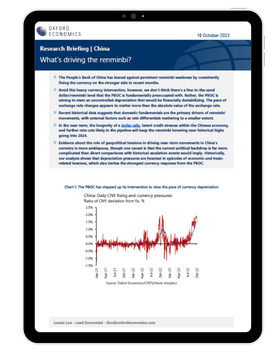What’s driving the renminbi in China?

The People’s Bank of China has leaned against persistent renminbi weakness by consistently fixing the currency on the stronger side in recent months. Amid this heavy currency intervention, however, we don’t think there’s a line-in-the-sand dollar/renminbi level that the PBOC is fundamentally preoccupied with. Rather, the central bank is concerned with ensuring that depreciation expectations remain anchored.
What you will learn:
- Recent historical data suggests that domestic fundamentals are the primary drivers of renminbi movements, with external factors such as rate differentials mattering to a smaller extent.
- In the near-term, the longevity of a dollar rally, latent credit stresses within the Chinese economy, and further rate cuts likely in the pipeline will keep the renminbi hovering near historical highs going into 2024.
- Evidence about the role of geopolitical tensions in driving near-term movements in China’s currency is more ambiguous, though one caveat is that the current political backdrop is far more complicated than direct comparisons with historical escalation events would imply.
- Historically, our analysis shows that depreciation pressures are heaviest in episodes of economic and trade-related tensions, which also invites the strongest currency response from the PBOC.
Tags:
Related Posts

Post
Nowcast shows wage growth slowing sharply
Our sentiment data, developed with Penta, suggests that UK private sector wage growth slowed sharply in March and early-April. If official data mirrors our sentiment indicator, it should keep the Monetary Policy Committee on track to cut interest rates in the summer.
Find Out More
Post
The euro and depreciation – shake, shake it off
Our new forecast assumes a slower euro appreciation against the dollar over the coming years than we previously anticipated. Relative productivity, terms of trade, and the current account will likely be less supportive of the euro than we thought. In addition, a stronger stock market than initially envisaged will attract more financial flows into the US than we had expected.
Find Out More
Post
New ECB framework a versatile toolkit for uncertain times
The European Central Bank's updated monetary policy framework retains key advantages of the previous system and in our view is well-tailored to the eurozone's bank-dominated financial infrastructure. It also gives the ECB a versatile toolkit allowing it to react flexibly to episodes of market stress.
Find Out More